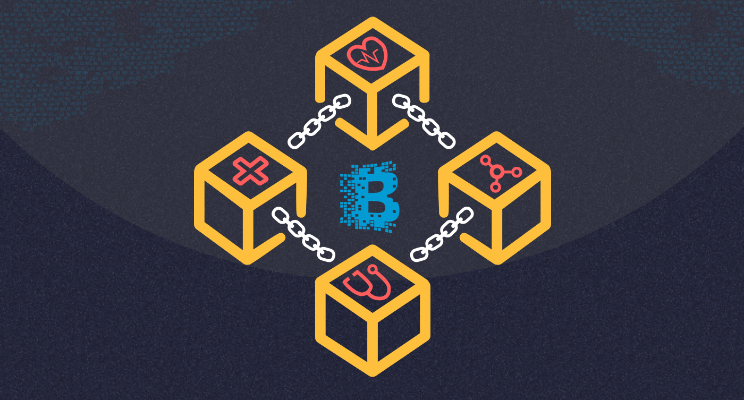
There is a lot of buzz around Bitcoin and other forms of cryptocurrency as a new kind of payment technology and how it can change our future. I am going to take a different spin on what is really interesting about cryptocurrency. There is much more behind cryptocurrency and Bitcoin than being a new way to make a payment. The technology that Bitcoin is built on is extremely interesting and has many other applications. The underlying tech that drives cryptocurrency is called blockchain which is a new way to track and log information that can be applied to other industries like healthcare. The real question is where will blockchain be applied and how will it work in our future.
Before we jump into how blockchain can help the healthcare vertical, the most important concept of what blockchain is, simply put, is a way to distribute a ledger. What this means is there are many different copies of a ledger with the same information from different parties. If someone loses a ledger or if someone tries to completely delete data from a ledger, there are many different copies that also have that same information logged. Having multiple ledgers from different parties creates a whole new concept of access and reliability. There isn’t one central source of truth but many copies or sources of truth.
One transaction happens and after the encounter, a trusted party would validate the transaction with an access key. An app running blockchain would timestamp the verified “block” and add it to the chain of older blocks in sequential order, hence adding a block to the chain. Then the transaction would be distributed to other ledgers.
How and why apply blockchain in healthcare?
1. Patient Medical Verification
Let’s take an example: If an X-Ray is taken of a patient, the patient shouldn’t have to take that X-Ray again if they go to a completely separate provider at a completely separate medical organization. By eliminating unnecessary X-Rays, expenses go down and the patient is exposed to less radiation.
If both providers in different organizations have a blockchain app with a copy of the patient’s data, they can look at the blocks to see when the last X-Ray has happened. If an X-Ray was taken recently, a provider can ask for a copy of that X-Ray or look at the chain if it includes that type of information in it.
Medical data isn’t siloed to one location and patient care improves.
2. Better Security and Backups
Blockchain can be applied to protect internal infrastructure within an organization. Having many copies of the blockchain ledger within a healthcare organization with independent parties having access to the separate copies under lock and key creates redundancy like we have never seen before. If we look at how a lot of healthcare organizations operate today, the organization might have one central database, with one team managing the database. There is one point of failure, with the team, and with that one database. What happens if a hacker gets access and encrypts the database? Well this has happened with hackers encrypting full hospital databases. In the past the hackers blackmailed hospitals to get access to their own data. If implemented correctly, blockchain would protect against this type of ransom attack and other types of catastrophes like data corruption or hardware failure.
3. Bringing Down Healthcare GDP
We can bring down the spend on the U.S. GDP if we actually leverage Blockchain for fraud and duplicate charges for procedures and discrepancies using the technology for medical billing. CMS estimated that health care spending will account for 19.9 percent of GDP by 2025, up from 17.8 percent in 2015.
In theory if we tracked all charges, we can validate charges across different Blockchain instances to see if everything for a patient has been done and where. We would have a better check and balance process to see what billing has been completed for a patient and who covered a patient for what. Medical billing errors, duplicate charges and fraud checks could happen in real-time as audits of medical codes happen, looking at codes like ICD-10 and CPT codes.
(ICD-10 and CPT codes would be part of the Blockchain)
4. Cryptocurrencies for Patient Payments
Cash medical practices might adopt and accept Cryptocurrency as payment from patients in the near term future, but for the larger practices and institutions to adopt Cryptocurrency a major shift would have to happen. The change would have to come from the healthcare insurance company industry. The big change that I see as the core driver would be Medicare. Medicare would have to back some implementation of Cryptocurrency. Generally most U.S. insurers follow Medicare, and if Medicare were to change, we would for sure see a fast adoption of accepting these types of payments.
It is amazing to see companies starting to accept Cryptocurrency, the healthcare industry generally lags behind when it comes to change, so it will be interesting to see how accepting new forms of payment will play out.
Summary
As per my guess of where we will see blockchain’s biggest adoption, I would say it will be within organizations initially, not outside or from groups/organizations working together. Blockchain adoption would happen within an organization, one organization at a time, rolling the technology out to protect the company like I mentioned in point number two above.
Healthcare has been lagging to adopt newer technologies with a large part of the medical industry still running on fax machines and on paper. It will be fun to see how this new technology will come into play in healthcare.
Daniel Kivatinos is the COO and cofounder of drchrono, an integrated EHR platform that connects doctors, patients and health data to improve patient care. Daniel drives direction, brand vision, and business strategy for drchrono. Follow him on Twitter @danielkivatinos
